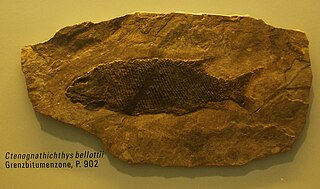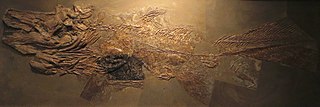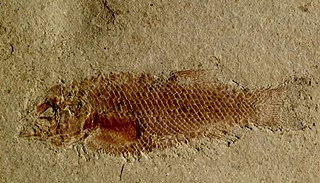
Birgeria is a genus of carnivorous marine ray-finned fish from the Triassic period. Birgeria had a global distribution. Fossils were found in Madagascar, Spitsbergen, Germany, Switzerland, Italy, Slovenia, China, Russia, Canada and Nevada, United States. The oldest fossils are from Griesbachian aged beds of the Wordie Creek Formation of East Greenland.
Laugia is an extinct genus of coelacanth fish which lived during the Induan age of the Early Triassic epoch in what is now Greenland. The type and only species, Laugia groenlandica, was collected from the Wordie Creek Formation and described by Erik Stensiö. The genus is named after Lauge Koch.
Axelia is an extinct genus of prehistoric lobe-finned fish, which belonged to the family of Coelacanthidae. It lived during the Smithian age of the Early Triassic epoch in what is now Spitsbergen, Svalbard. Fossils were found in the "Fish Niveau" of the Lusitaniadalen Member of the Vikinghøgda Formation.
Wimania is an extinct genus of coelacanth lobe-finned fish that lived during the Early Triassic epoch in what is now Svalbard. Fossils were found in the Smithian aged "Fish Niveau" of the Lusitaniadalen Member of the Vikinghøgda Formation. Wimania belongs to the family Coelacanthidae. It is named after Carl Wiman.

Whiteia is an extinct genus of prehistoric coelacanth fish which lived during the Triassic period. It is named after Errol White.

Australosomus is an extinct genus of prehistoric ray-finned fish that lived during the Early Triassic epoch in what is now Greenland, Kenya, Tanzania, Madagascar, South Africa and Canada.
Helmolepis is an extinct genus of ray-finned fish that lived during the Early Triassic epoch in what is now Greenland, Madagascar and Canada. Species of Helmolepis are small. This genus is closely related with Platysiagum.

Ctenognathichthys is an extinct genus of prehistoric bony fish that lived during the Anisian and Ladinian ages of the Middle Triassic epoch in what is now southern/southeastern Switzerland and northern Italy.

Heptanema is an extinct genus of prehistoric coelacanth from the Middle Triassic (Ladinian) of northern Italy and southern Switzerland.

Mylacanthus is an extinct genus of prehistoric coelacanth lobe-finned fish that lived during the Smithian age of the Early Triassic epoch in what is now Svalbard.
Moenkopia is an extinct genus of prehistoric sarcopterygians from the Coelacanthidae found in the Middle Triassic Moenkopi Formation of Arizona. The type, and only species, M. wellesi, was named in 1961 in honour of Samuel Paul Welles. It is only known from the holotype, UMCP 36193, a partial skull consisting only of the basisphenoid that was collected in 1939 or 1940 by Samuel Welles and briefly noted on by him in 1947, and other assorted specimens found before 2005 in the Radar Mesa by S. J. Nesbitt, W. G. Parker and R. B. Irmis.

Trachymetopon is an extinct genus of prehistoric coelacanth from the Jurassic of Europe. Fossils have been found in the Early Jurassic Posidonia Shale of Germany the Middle Jurassic Marnes de Dives of France, and probably the Late Jurassic Kimmeridge Clay of England. Only one species has been named, Trachymetopon liassicum, described by Henning in 1951 from an almost complete specimen found in the Lower Toarcian of Ohmden in Baden-Württemberg. Another specimen is known from the same site, and two older specimens come from the Sinemurian of Holzmaden. The holotype of this species is 1.6 metres in length. A giant specimen of an undetermined species of Trachymetopon found at the Middle Jurassic Falaises des Vaches Noires of Normandy. This specimen, composed of a 53 cm long palatoquadrate, belongs to an individual 4 metres (13 ft) in length. A basisphenoid found in a museum in Switzerland that likely originates from the same locaity probably belonged to an individual around 5 m (16 ft) long, making Trachymetopon the largest of all coelacanths alongside Mawsonia. A study published in 2015 revealed that this coelacanth belongs to the Mawsoniidae. Trachymetopon is one of the few known mawsoniids to have been exclusively marine, while most of the other members of the group have lived in fresh and brackish waters.
Spermatodus is an extinct genus of prehistoric coelacanth lobe-finned fish, which lived during the Artinskian age of the Cisuralian epoch in what is now Oklahoma and Texas, United States.
Scleracanthus is an extinct genus of prehistoric coelacanth lobe-finned fish. It lived during the Early Triassic epoch in what is now Spitsbergen, Svalbard.

Acentrophorus is an extinct genus of prehistoric ray-finned fish from the Roadian to the Wuchiapingian of England, Germany (Kupferschiefer), Italy and Russia. There may also be a Triassic occurrence in Australia.

Bobasatrania is an extinct genus of prehistoric bony fish that survived the Permian-Triassic extinction event. Fossils of Bobasatrania were found in beds of Changhsingian to Ladinian age. It was most speciose during the Early Triassic.
Boreolepis is an extinct genus of prehistoric bony fish that lived during the Wuchiapingian age in what is now Clavering Island, Greenland, and Vologda Oblast, Russia.

Boreosomus is an extinct genus of Triassic ray-finned fish. It was first described from the Arctic island of Spitsbergen, but was later also discovered in other parts of the world. The type species is Boreosomus arcticus.

Ardoreosomus is an extinct genus of marine ray-finned fish. It was described from the Induan aged Candelaria Formation of Nevada, United States, which was located near the equator during the Early Triassic epoch. It contains only one species, A. occidentalis (monotypy).

Pygopterus is an extinct genus of prehistoric bony fish that lived during the Wuchiapingian to Olenekian ages in what is now England, Germany, Greenland and Svalbard (Spitsbergen). It is one of the few genera of ray-finned fish known to cross the Permian-Triassic boundary.
















